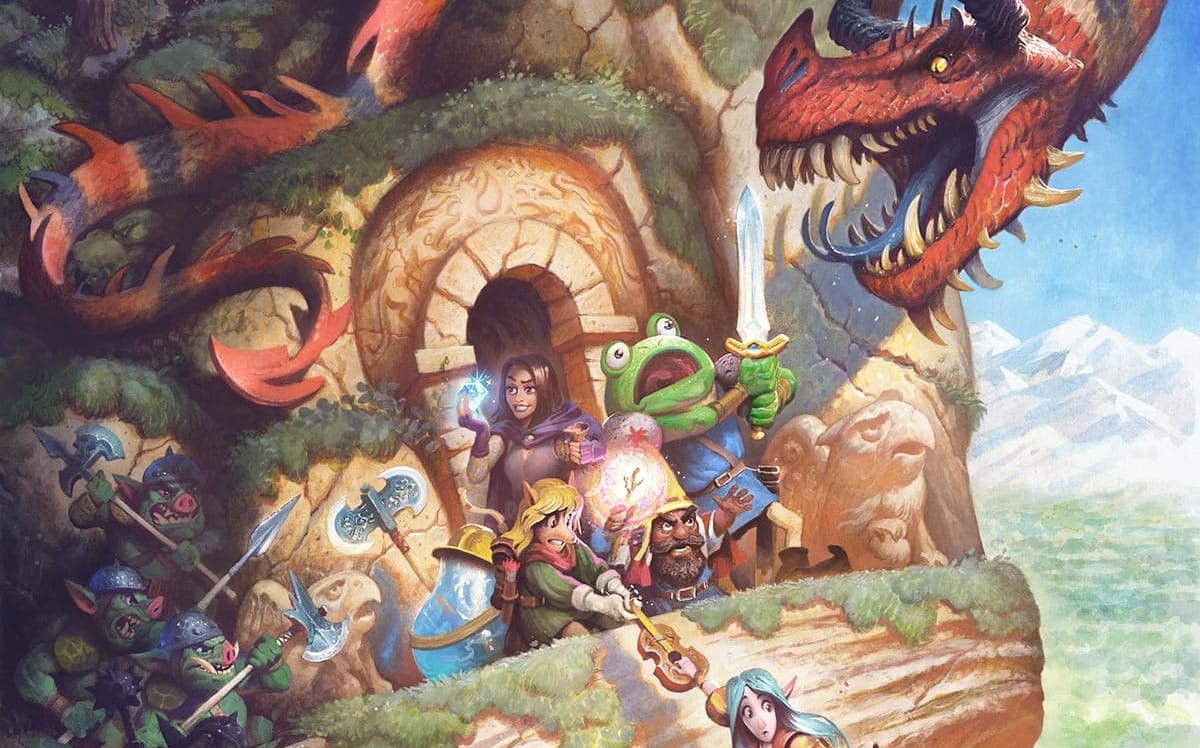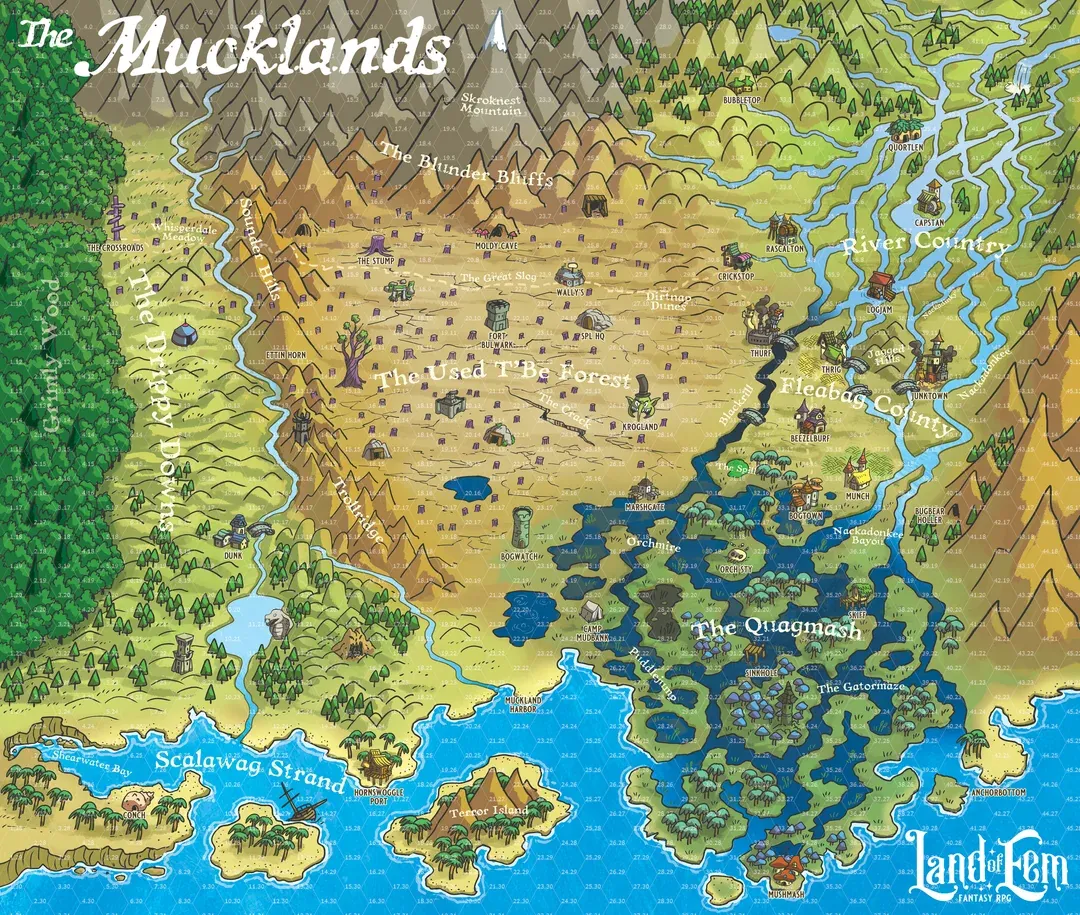
Land of Eem is a lot of things at once. As a classic boxed set, it contains truly everything you need to play this RPG, an exploratory adventure for teenagers and young adults. While the total price is around $150 with shipping included, the quality and amount of materials make that a more than reasonable price for people who intend to actually use them and play the game. The raw materials of the boxed set include a core book, bestiary, setting book, GM screen, large foldout map, high quality dice styled as slimes digesting skulls, and 6 colorful character meeples. The box that comes with this set is itself a dice rolling tray. The game itself is a mix of OSR with hex crawl rules and light-PBTA, rounding out to make a game with satisfying complexity but approachable rules. It is a touch simplistic, but the amount and quality of material, as well as the younger intended audience, means this is almost perfectly built. I say almost only because there is so much information here it can be hard to wrap your head around the entire experience.

The bestiary shares 26 entries with the core, probably so that it isn’t strictly necessary to buy the bestiary or boxed set as a whole. Every single monster comes with its own illustration, which are artistically consistent but conceptually varied. In fact, most of every book is full of illustrations which add flavor but don’t clutter the layout. Campaign Setting is 430 pages which connects directly to the map. There are hundreds of locations and each has their own flavor worth exploring. The map is freely available online (please don’t metagame). It’s made of good thick cardboard, and would take weeks or months to cross in game, easily years out of game. The GM screen is well laid out with colors and resources, and great art on the outside.
The dice mechanics ask you to roll a d12 (adding or subtracting a skill modifier) with a PBTA-lite chart for results: 1-2 is complete failure, 3-5 failure with a plus, 6-8 success with a twist, 9-11 a standard success, and 12 a complete success, i.e. with an extra benefit. Some rolls do have static difficulties. Maximum plus or minus 3. Borrows advantage/disadvantage from 5E and players have permanent proficiencies or disadvantages. Despite the volume of material here, the layout makes it all approachable. It’s clearly broken into important rules text and examples, with important terms or rules bolded. That approachability does start to break down later in the game, not due to the way the rules are presented but because of the number of small details to track.

Characters have 4 attributes, Vim, Vigor, Knack, and Knowhow, all of which contain 4 associated skills and range from -2 to +2. Those attribute names are a bit odd, I think, and it isn’t always clear which skull falls under each. Why exactly is Vim connected to Perception, for instance? The character sheet design makes this a minor problem, as it groups the skills together next to their associated attribute. Characters also have Courage (HP), Attack modifier (equal to Vigor), Defense (the opposite of your to Knack, it subtracts from incoming attacks) and your Quests, a metacurrency which refreshes each session.
Apart from equipment, characters are differentiated by abilities, connected to your class and race or magic items. The class sheets are, like everything else, concise and well organized. One sheet tells you every class ability available to you now and in the future. Those classes include Bards, Knight-errants, Dungeoneers, Loyal Chums, Gnomes, and Rascals. Mostly they are what they sound like, but the Chum is a support character and the Rascal functionally a rogue. To be clear, Gnomes aren’t necessarily a race so much as a type of wild magic sorcerer.
As the Folk are concerned, you have a lovely number of options, built into a setting that keeps them from being meaningless clutter. Humans are a rarity in a world full of Boggarts, psychic mushrooms, whales, skeletons, gelatinous goos, and more. They all have some skill bonuses and quirks/perks which are positive and negative features. You can buy more abilities and improve your skills with experience, and you will be impressed at how powerful those few abilities are. More than just number improvements, they add a ton of flavor and freedom to your character.

Equipment is also more complicated than I would have expected. To start with, it has a d400 random table, and that’s before you get to the magical, or Magnificent Item chart. This contains extra features that you can add onto normal items, like entangling, lucky, or quick weapons. Moreover, those options are broken into weapon types, so Bladed, Blunt, and Ranged weapons all have their own options. Those options extend to armor as well, which contain their own layer of complexity. The armor types have armor reduction, but also specific penalties or bonuses for different skill checks, in and out of combat. Rather than counting your money in terms of individual coins, Eem relies on usage dice for the coin types. This means that an item that would cost copper or silver coins triggers a roll of its associated die, which is reduced to a lower die type on a low roll.
Eem contains a crafting system if you want to gather some of the 200+ components from Beast, Elemental, Fish, or Herb subcategories. Obtaining components means taking time travelling, a precious resource, and rolling a skill check to find them. The components are all located in specific area types and add specific traits on the Magnificent Item chart. You could ignore this crafting system entirely, as I’m sure many tables will, but you could alternately make it a primary focus of your game, mapping out areas to explore for their components as you plan out the path that leads to your perfect weapon. In a way, this is too much information. A party that’s even a little engaged with crafting will soon find itself tripping over the components, all of which have details to track. The amount of work it takes to track and use this information is sure to make many tables ignore it.
Combat rules are an element of the broader Conflict system, which contains four phases: Parley, Improvise, Run, and Combat. Situations only break down into fights if you can’t find another way to avoid the battle. The rules here are most developed for the first and fourth phases, but I appreciate the point: to hammer home that players have choices in how to approach these encounters, and that combat is only one of those choices. Time and again I’ve seen GMs lamenting, confused, desperate to try to communicate to players that fighting to the death is not the only way to proceed, and it’s great to see the attention Eem pays to that principle. Actual combat is not complicated: roll Perception and act before enemies if you roll 6 or more. Then roll Attack - the opponent’s Defense, reducing Courage by your weapon’s Dread, or damage. Enemies have unique behaviors for when they are succeeding or losing combats, adding a ton of flavor and value to the Bestiary. Other rules relate to lighting, exploration, mounts, and time, to help add to the hexcrawl feel.
Overall, this is a fantastic game, full of great quality and small considerations. It’s easy to learn for players, but difficult to learn for the GM. There’s so much here with so much detail, it’s a lot to digest and run. The map/book combination will make overall game prep largely effortless, but the components and inventory system, mounts, and equipment will make for a lot of unintended complexity while you’re at the table. As you may have seen a few days ago, Eem is being expanded right now, with an Underlands adventure adding to the Mucklands, and a new version of the game for younger players.
Land of Eem: Deluxe Edition Boxed Set
Excellent
Land of Eem is approachable and visually stunning, while also being ambitious and expansive in both scope and mechanics. It’s perfect for players eager to explore a richly imagined world, and for GMs willing to manage a little extra prep and bookkeeping to unlock its full potential. Its design aims are clear and mostly achieved: a welcoming RPG that respects its audience’s intelligence while offering deep engagement for those who want it.
Pros
- Exceptional component quality makes for immense value
- Layout and art communicate rules and feelings effortlessly
- The map and setting book makes for easy yet dense exploration
Cons
- Components are a lot to manage, possibly too much
- This complexity might not be the best for the younger intended audience
- Crafting in particular is a lot of management
This review is based on a retail copy provided by the publisher.
